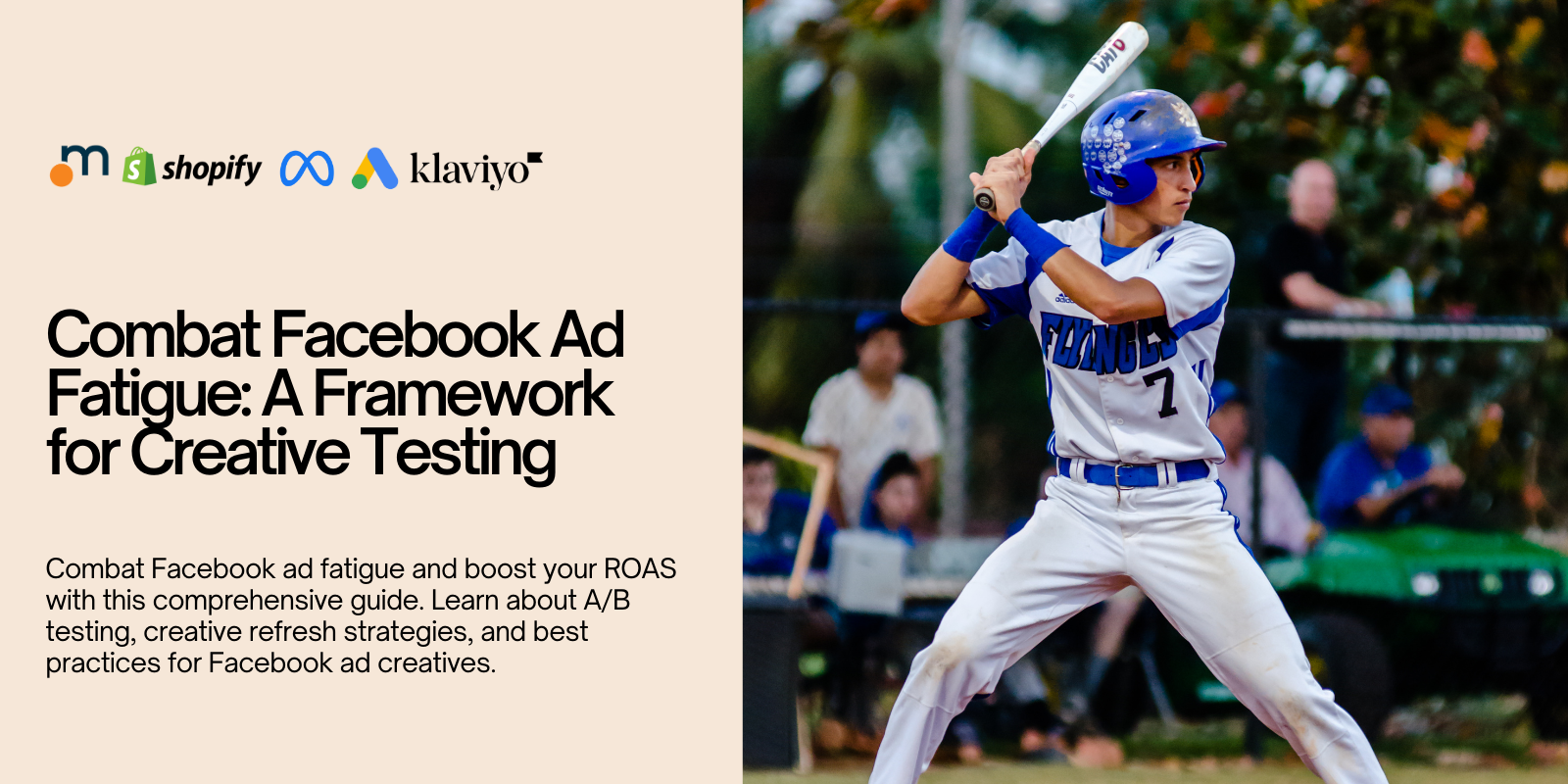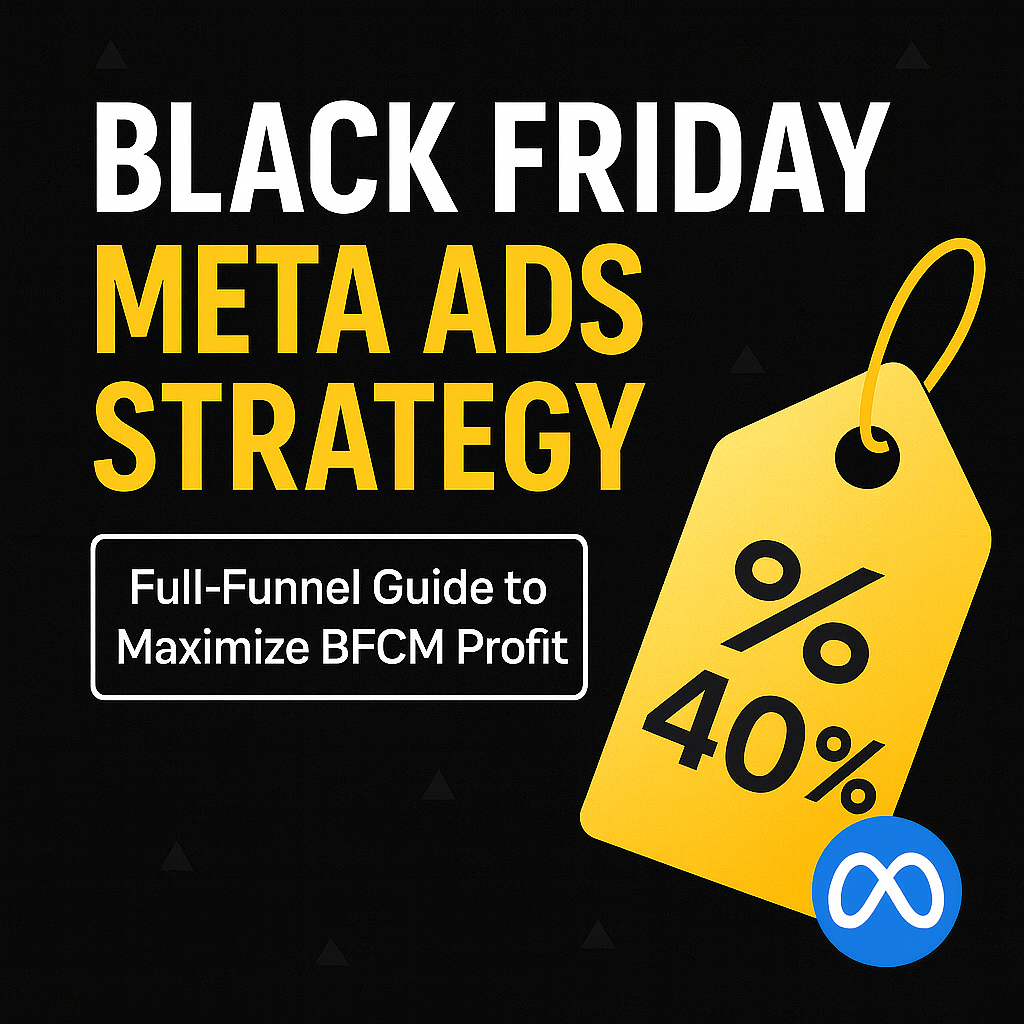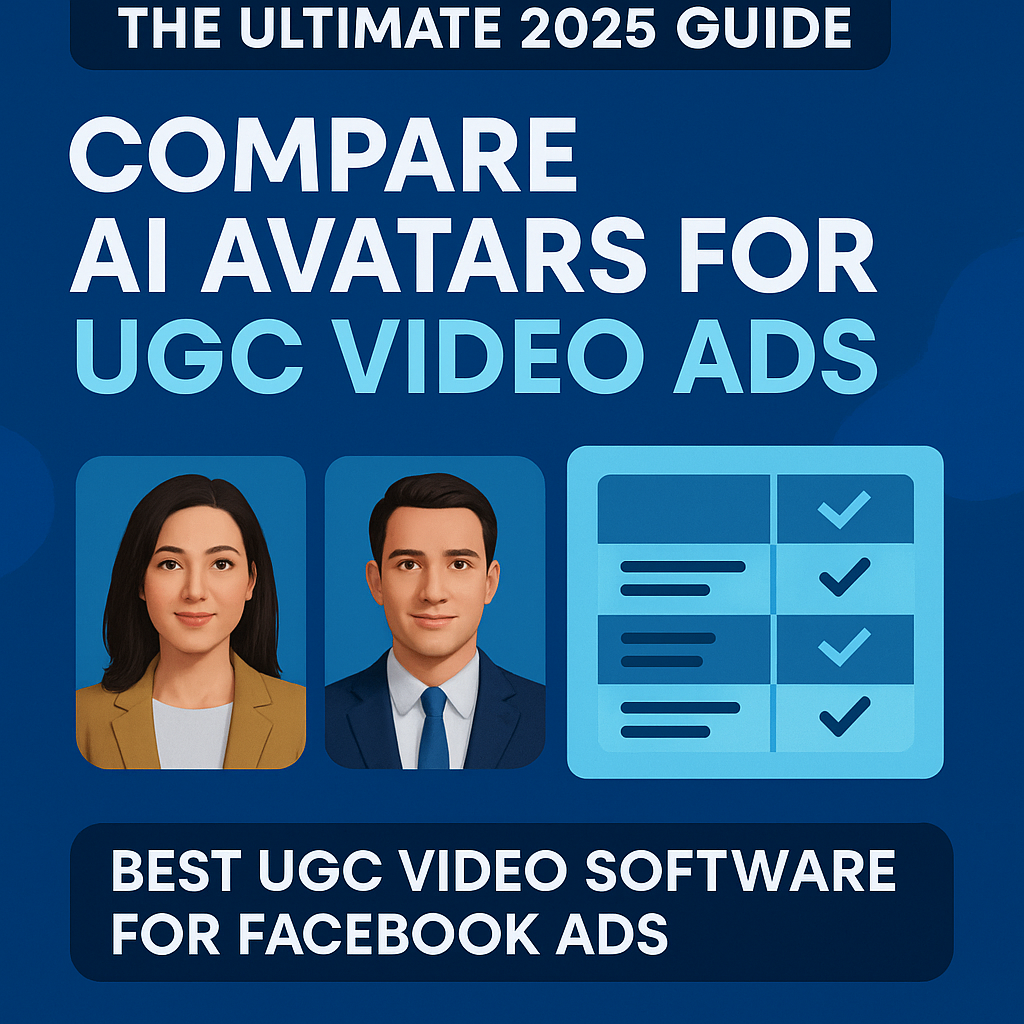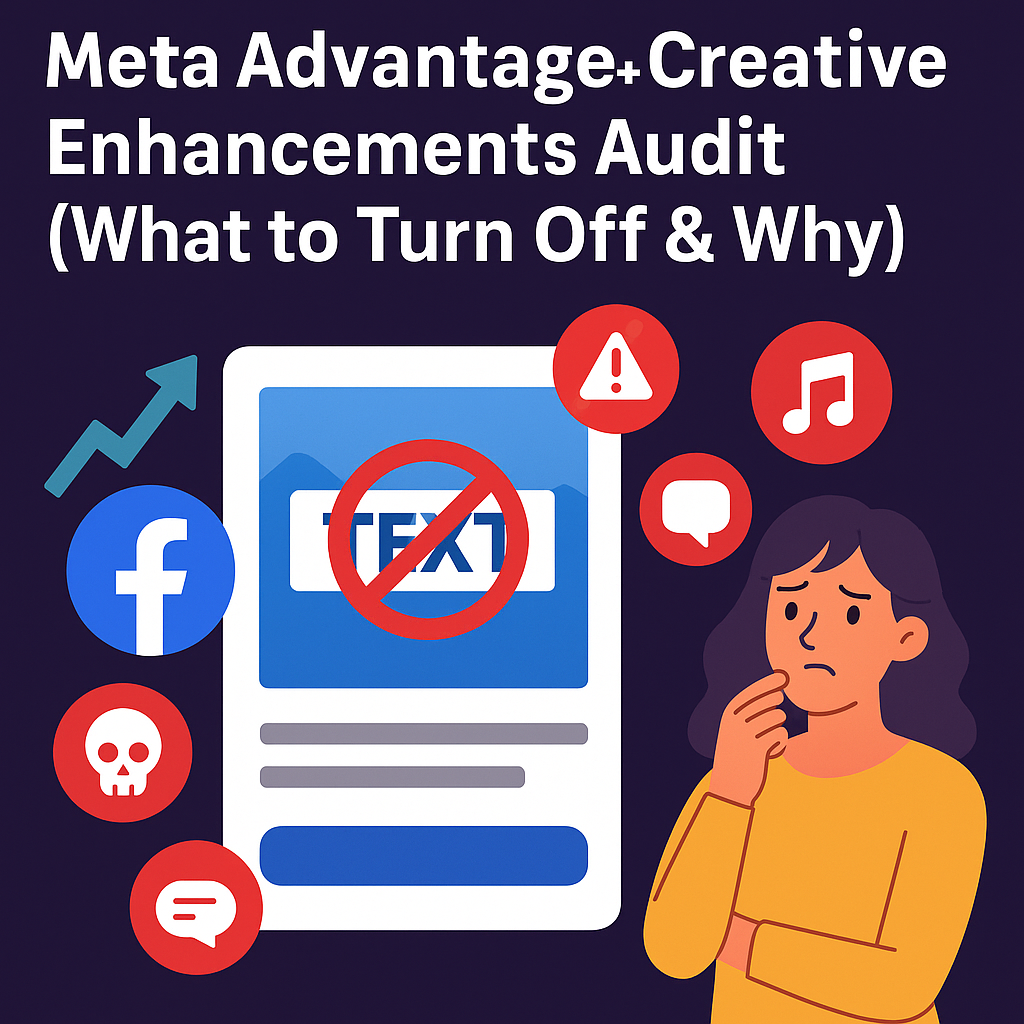Fighting Facebook ad fatigue is one of the biggest challenges facing performance marketers today. Even your best-performing ad creative can start to lose its impact after being shown too many times. This overexposure leads to Facebook creative fatigue, your audience stops paying attention, and your engagement rates begin to slide which severely impacts your conversion rates.
This isn’t a sign that your product or strategy is broken. It’s a sign of ad fatigue, a common obstacle that smart advertisers know how to overcome.
In this guide, you’ll learn:
- How to recognize the signs of Facebook ad fatigue
- Proven ad fatigue solutions using creative testing frameworks
- How to refresh, iterate and optimize your ads for long-term success
If you’re serious about Facebook ad optimization, this is your playbook.
Table of Contents
What Causes Facebook Ad Fatigue? (And Why It Happens Faster Than You Think)
Ever played your favorite song on repeat until one day, you couldn’t stand it anymore?
That’s exactly what happens with Facebook ads. When your audience sees the same creative over and over again, it loses its novelty. What once stood out now blends into the feed. This is Facebook creative fatigue in action, and it’s more common (and costly) than most performance marketers realize.
Here’s what’s happening:
Performance starts dipping – You’ll notice lower CTRs, rising CPAs, and fewer conversions. These are clear signs of Facebook ad fatigue.
Our brains crave novelty – We’re wired to pay attention to what’s new and ignore what’s familiar. Once your ad becomes “background noise,” it stops getting clicks.
Message saturation – Repeating the same messaging too often wears it thin. Your audience tunes out.
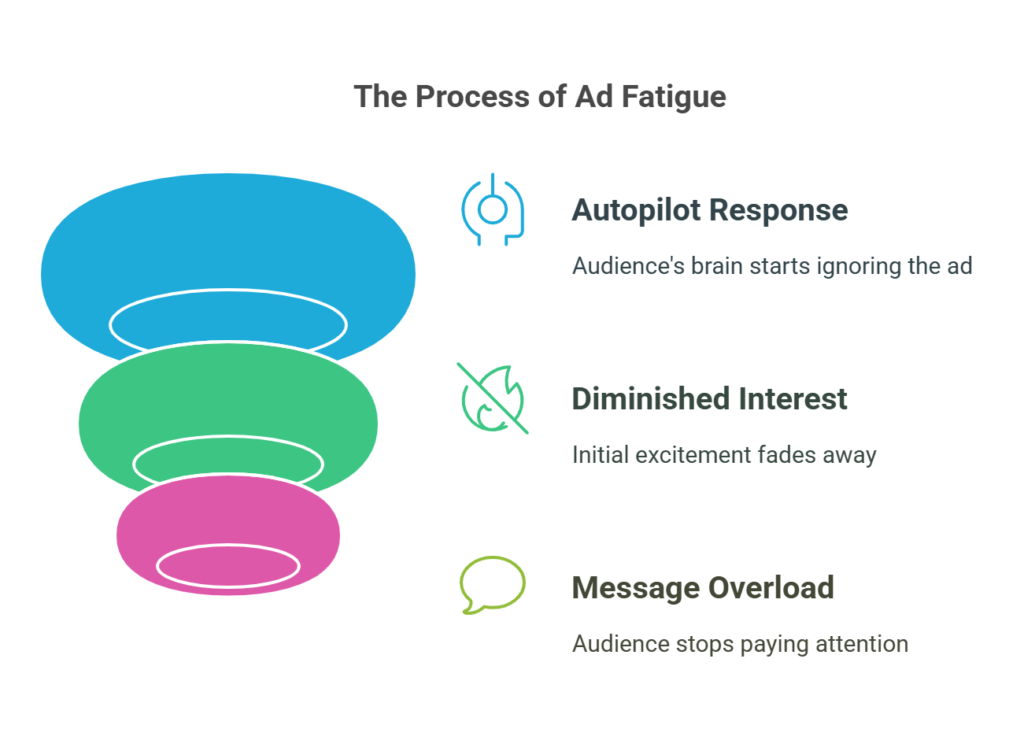
Most Facebook ad fatigue sets in after a frequency of just 3–4. Monitor this metric closely in Ads Manager to catch early signs of decline before performance tanks.
In a recent campaign for a client, we had to shift focus away from the U.S. market due to rising tariffs that impacted sales. We pivoted to advertising in Canada, but that came with its challenges.
The Canadian market is 10x smaller than the U.S., meaning we quickly ran into high ad frequency, our audience was seeing the same ads 6 times or more. As performance declined, it became clear we were facing severe Facebook creative fatigue.

To fix it, we ramped up creative iteration and tested new creatives every week, and reduced our Frequency by almost 19%. This extends the lifespan of our campaigns despite a limited audience size. The lesson? In smaller or niche markets, you must refresh creatives more often to avoid burning out your audience.
Luckily, ad fatigue isn’t catastrophic; it’s just a signal to refresh. In the next section, we’ll show you how to fight it with a repeatable creative testing system.
How to Quantify Facebook Ad Fatigue: Use the Ad Fatigue Signal Score (AFSS)
Before your ads completely burn out, you can spot warning signs by combining three core metrics:
AFSS = (Frequency × CPC) ÷ CTR
- Frequency: How often the same user sees your ad
- CPC (Cost Per Click): Rising costs often signal declining relevance
- CTR (Click-Through Rate): Fatigue causes this to fall
Monitor the AFFS Formula to gauge fatigue:
- AFSS < 10 = Healthy performance
- AFSS 10–20 = Warning signs of ad fatigue
- AFSS > 20 = Urgent creative refresh needed
You can calculate this manually using Ads Manager or set up alerts in your preferred reporting tool.
Ad Fatigue Solutions: A Value-Driven Facebook Ad Testing Framework
Fighting ad fatigue requires more than just testing random variations. It takes a purpose-built, conversion-focused framework that aligns directly with your performance goals. Here’s a refined 6-step system based on real-world insights, not theory.
Step 1: Set Conversion-Centric Goals
In eCommerce, we’re not testing for fun, we’re testing to make more sales. Every creative you launch should directly support this outcome.
- Start with your KPIs: CAC, ROAS, checkout-to-purchase ratio.
- Create with benchmarks in mind: I focus on developing creatives that meet or exceed 80% of the performance of my best ads.
- Eliminate vanity metrics. If it doesn’t move the needle on conversions, it’s not a win.
Step 2: Allocate Budget and Isolate the Right Audience
I dedicate 20% of total ad spend to creative testing. This ensures new concepts don’t cannibalize existing winners. But testing only works if the data is clean.
- We exclude email subscribers, previous engagers, and anyone who viewed our video ads in the last 365 days.
- This isolates performance from existing biases and allows us to test creative strength with a truly cold audience.
Testing takes resources. Figure out how much you can comfortably allocate to your testing efforts. This will determine how many ad variations you can create and how far your reach can extend.
A key factor here is your CPM (Cost Per Mille), which is the cost of showing your ad to 1,000 people. Your weekly testing budget is $1,000, and your CPM is $20. This means you can reach 50,000 people with your budget. Why is this important? Because you need a decent number of eyeballs on your ads to get reliable data so you can decrease Facebook ad fatigue.
Step 3: Diagnose What’s Broken, Then Build Variations That Convert
You don’t always need a new concept; sometimes, you need better execution. Here’s how we decide what to tweak:
- Look at engagement vs. conversion. If people are commenting but not buying, we dive into those comments to figure out why.
- If performance is lagging, we dissect the creative by its core components: hook, offer, CTA, and structure.
- We lead with the strongest performing element, headline, image, and format, and rebuild around it, sometimes even with AI.

Santevia Water Systems recently ran multiple video ad variations for their fluoride-removing glass water filter. After three days, they turned off one version but kept the other two running. Why? The winners were clearly delivering, either through better engagement, conversions, or both.
This is creative iteration in action. The visual and product stayed the same, but subtle changes in copy, pacing, and overlays likely drove performance differences. Instead of starting from scratch, Santevia used testing to optimize what was already working.
Step 4: Match Test Duration to Budget Velocity
There’s no fixed number of days to run a test. The real constraint is data velocity.
- Bigger budget = faster results.
- We evaluate success based on how quickly a creative hits (or misses) our internal KPIs.
- If performance is unclear, we let the test breathe; if it’s far off the mark, we cut early.
Step 5: Prioritize Simplicity Before Complexity
Start with A/B tests to isolate what works. Only move to multivariate testing when you have a winning foundation.
- A/B testing helps you identify the winning asset or message.
- Multivariate testing is ideal for refining combinations, but it requires a larger budget and higher volume.
- Don’t run complex tests unless the traffic supports statistical significance.
Step 6: Analyze with Intent, Iterate with Direction
Creative testing doesn’t end with a winner. You need to know why it worked, how long it lasts, and when to evolve it.
- I use an internal Google Sheet to track every test, including KPIs, format, concept, and outcome.
- The goal is not just to iterate, but to create a system that feeds your next winner before the current one burns out.
The difference between struggling brands and scaling ones often comes down to this: disciplined testing, structured iteration, and relentless focus on the metrics that matter.
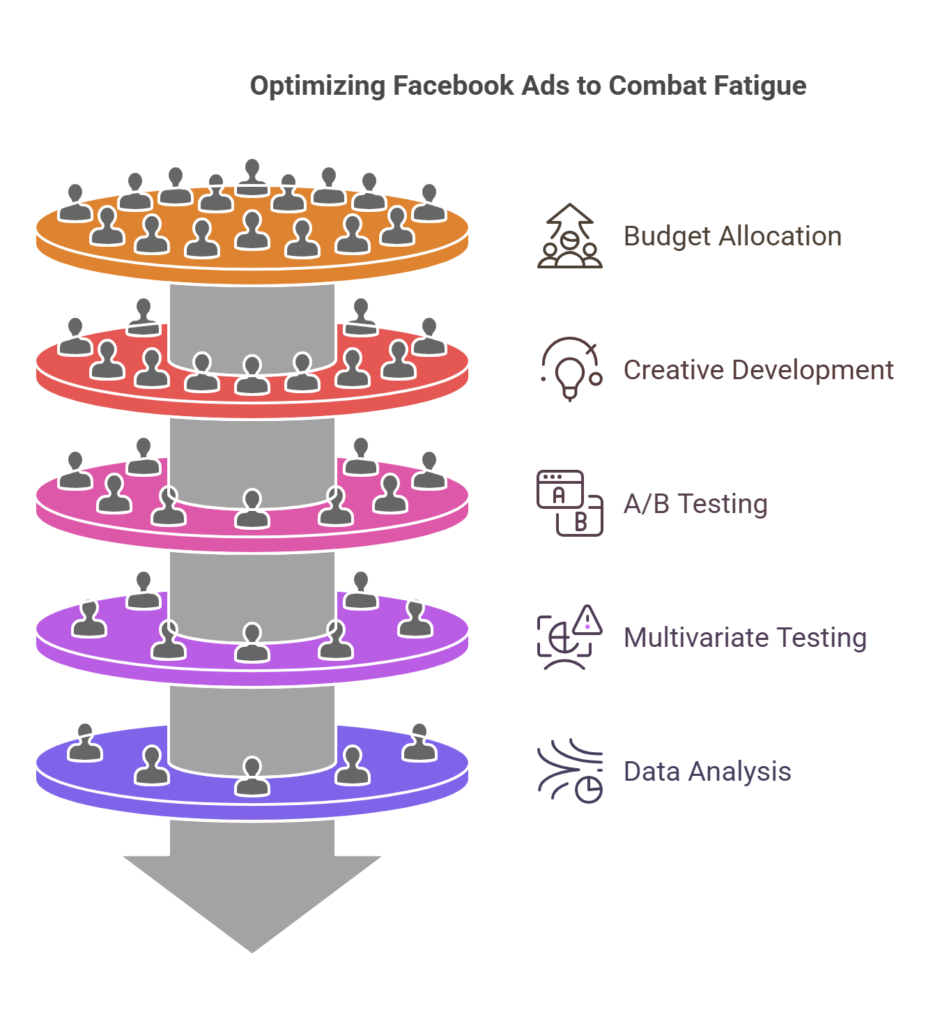
Facebook Ad Testing Toolkit: Tools That Keep Your Process Sharp
Tools matter—but only if they enhance your process, not complicate it. Here are the platforms and resources I recommend to streamline testing and extend the life of your best-performing ads.
Facebook Ads Manager
The baseline. It gives you what you need to A/B test, monitor frequency, calculate ROAS, and manage creative fatigue manually. Know how to navigate breakdowns, filters, and custom reports if you want to catch fatigue early.
Creative Iteration Tracker (Internal Sheet)
I use a custom-built Google Sheet to log:
- Creative variants
- Performance by KPI (CTR, CAC, ROAS, purchases, etc.)
- Testing outcomes (scale, iterate, pause)
- Notes on audience feedback and next steps
This isn’t just documentation—it’s a roadmap for future winning ads.
Motion or Pencil (for Rapid Creative Production)
When I need to scale creative volume fast, tools like Motion or Pencil help produce iterations quickly without sacrificing brand voice. Ideal when you need multiple hooks for a single product.
Meta Experiments (Built-In A/B Testing)
This tool lets you test variables like audience, placement, or creative, and view clean lift results in a split test format. Especially useful if you’re not using third-party tools and want statistically clean test environments.
Attribution Platforms (Wicked Reports, Triple Whale, etc.)
For performance-focused testing, attribution is everything. If you’re not measuring post-purchase value accurately, you’re optimizing based on flawed data. I recommend tools that allow for blended models across ad platforms.
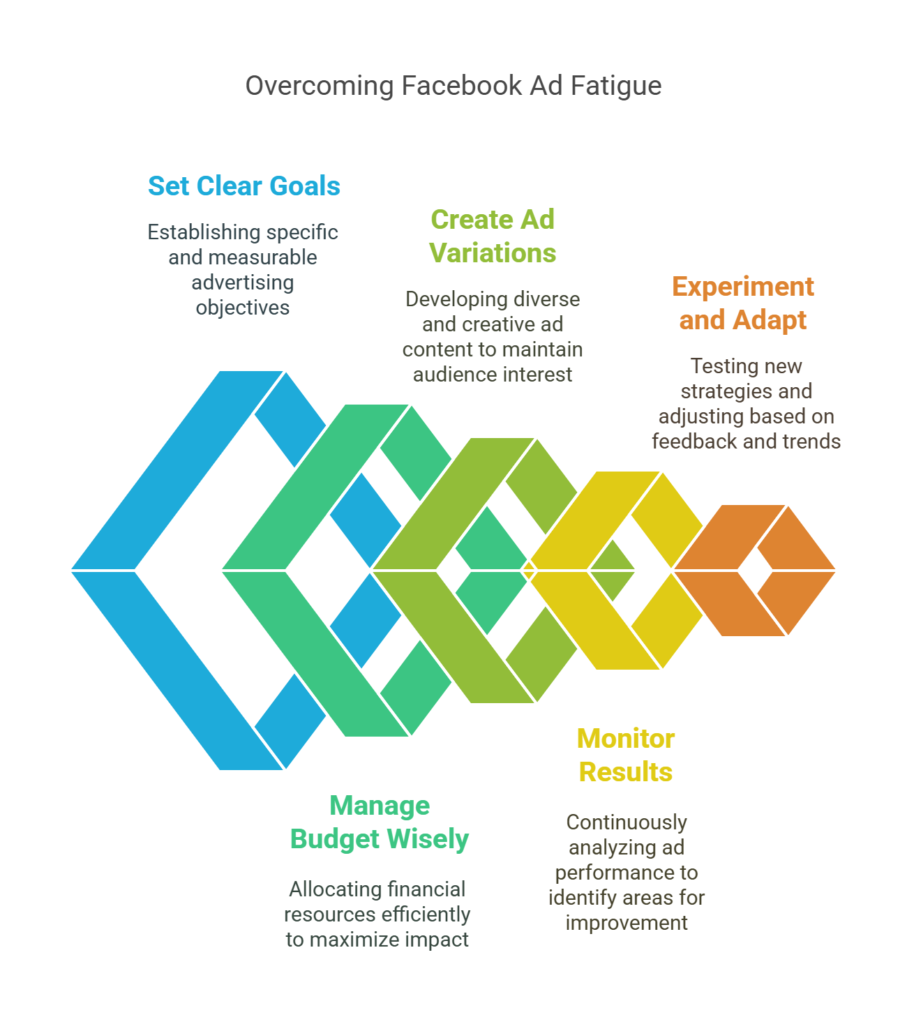
Final Thoughts: Conquer Ad Fatigue and Reclaim Performance
Ad fatigue is inevitable but completely solvable. The key is to spot it early, act decisively, and build systems that keep your ad account agile and responsive. With the right strategy, tools, and mindset, you’ll stop chasing trends and start building winning creative pipelines that scale.
Here’s your blueprint:
- Know your KPIs cold
- Test with purpose, not guesswork
- Refresh before results drop
- Document and repeat what works
If you’re serious about scaling on Facebook, fighting ad fatigue isn’t optional; it’s foundational.
Looking for a deeper creative iteration strategy? Check out our guide on scaling winning ads through creative iteration.
FAQ
What are the first signs of Facebook ad fatigue?
While there’s no single, definitive indicator, a few key metrics can signal the onset of Facebook ad fatigue. Keep a close eye on your click-through rate (CTR). A sudden or gradual decline in CTR, meaning fewer people click on your ad despite seeing it, often suggests that the creative is losing appeal. Similarly, a drop in engagement metrics like likes, comments, and shares can indicate that your audience is becoming less interested in interacting with your ad.
Finally, and perhaps most importantly, monitor your conversion rate. If fewer people take the desired action after clicking your ad (e.g., making a purchase or signing up for a newsletter), it could be a strong sign of ad fatigue. It’s crucial to analyze these metrics in context. Consider any external factors influencing performance, such as seasonality or changes in your target audience.
When is it time to refresh my Facebook ad creatives?
Determining the exact moment to refresh your creatives isn’t an exact science. Still, a combination of factors can guide your decision. First, establish a baseline for your ad performance. Track your key metrics (CTR, engagement, conversion rate) over consistent performance. This provides a benchmark to compare against future fluctuations.
Next, set a threshold for decline. For example, if your CTR consistently drops by 10% or more from your baseline, it might be time for a refresh. Also, consider the frequency of your ads. Facebook provides a ” frequency ” metric that shows the average number of times each user has seen your ad. A high frequency (e.g., above 3 or 4) suggests overexposure, increasing the likelihood of ad fatigue. Finally, trust your gut. If your ads have become stale or repetitive, it’s time for a change, even if the data isn’t screaming for it.
What metrics should I focus on to measure the success of my Facebook ad campaigns?
Facebook offers a wealth of data, but to truly gauge your ad campaign success, you must focus on metrics aligning with your goals if your aim is brand awareness, track metrics like reach, impressions, and brand mentions. These indicate how many people see your ads and talk about your brand.
For website traffic, prioritize click-through rate (CTR), website clicks, and landing page views. These show how effectively your ads are driving traffic to your site. If your goal is lead generation, focus on metrics like leads generated, cost per lead, and conversion rate. These measure how many leads your ads capture and how cost-effective they are. For sales, track conversions, revenue, return on ad spend (ROAS), and cost per acquisition (CPA). These reveal the impact of your ads on your bottom line.
What’s the difference between A/B testing and multivariate testing?
Both A/B and multivariate testing are valuable techniques for optimizing your Facebook ads, but they differ in their approach.
A/B testing (also known as split testing) involves comparing two versions of an ad where only one element is changed. For example, test two headlines while keeping the image, body text, and call to action identical. This allows you to isolate the impact of that specific element on ad performance.
Multivariate testing, on the other hand, will enable you to test multiple variables simultaneously. For instance, you could simultaneously test different combinations of headlines, images, and calls to action. While multivariate testing can provide more comprehensive insights, it requires significantly more traffic and data to achieve statistically significant results. A/B testing is generally more straightforward to set up and interpret, making it a good starting point for most advertisers.
What are some common mistakes to avoid in creative testing?
Even with the best intentions, creative testing can go awry if you’re not careful. Here are some common pitfalls to avoid:
Testing too many variables at once can make it difficult to isolate the impact of individual elements and lead to inconclusive results.
Not running tests long enough: Short tests may not gather enough data to reach statistical significance, potentially leading to misleading conclusions.
Ignoring statistical significance: Don’t jump to conclusions based on slight differences in performance. Ensure your results are statistically significant to have confidence in your findings.
Not having a straightforward hypothesis: Start with a clear idea of what you’re testing and why. This will help you design practical tests and interpret the results.
Not iterating based on results: Creative testing is an ongoing process. Use your findings to inform future tests and continuously refine your ad creatives.
How often should I update my audience targeting based on ad performance?
Regularly revisiting your audience targeting is key to combating ad fatigue and maintaining strong ad performance. Start by reviewing your ad performance data at least once a week. Look for trends in engagement, CTR, and conversion rates across different audience segments. If you notice specific demographics or interests are performing better or worse than others, consider adjusting your targeting accordingly. For example, your ads resonate particularly well with women aged 25-34. In that case, you might allocate more of your budget to that segment.
Also, keep an eye on your audience insights within Facebook Ads Manager. This tool provides valuable data on your audience’s demographics, interests, and behaviors, which can inform your targeting decisions. Don’t be afraid to experiment with new audience segments or refine your existing targeting based on your ongoing analysis.
What are some examples of compelling creatives that have successfully reduced ad fatigue?
There’s no one-size-fits-all answer, as compelling creatives depend on your brand, audience, and industry. However, here are a few examples of strategies that have helped businesses combat ad fatigue:
Dollar Shave Club’s video ads use humor and relatable situations to keep their audience entertained and engaged.
Shopify: The company showcases diverse entrepreneurs and businesses using its platform, providing social proof and inspiration to its target audience.
Mailchimp: They employ bold visuals, playful animations, and a distinct brand voice to create memorable and engaging ads.
Airbnb: They leverage user-generated content and authentic travel experiences to connect with their audience on an emotional level.
Key takeaways from these examples include:
Emotional connection: Tap into your audience’s emotions to create a lasting impact.
Humor and relatability: Making your audience laugh or relate to your ad can increase engagement and memorability.
Social proof: Showcasing testimonials, case studies, or user-generated content can build trust and credibility.
Strong visuals: Eye-catching images, videos, and animations can capture attention and convey your message effectively.
Unique brand voice: Develop a distinct personality for your brand that shines through in your ad creatives.

